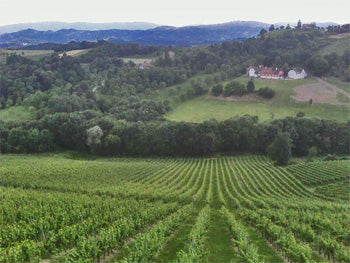
I recently spent four glorious days cruising through the wine regions of Austria. Though I’d been to some of the Austrian wine regions before, this was an opportunity to make it a more practical experience. I was on the look out for some exceptional producers that would fit in well with the rest of Goedhuis’ portfolio.

Austria makes some of the most exciting wines in the world. The only issue is that very few people know it. It is true that over the past 10-15 years their wines’ fantastic quality and Wines of Austria’s incredible marketing campaign have enabled their wines to surface to the connoisseur’s forefront. Some labels can be found in more accessible locations such as Waitrose and chain wine shops. Nonetheless, the wines still remain less known than other similar areas such as Germany or France’s Alsace. Yet, Austrian wines are different than those produced in either of these regions.
The first notable difference is Grüner Veltliner. Grüner is Austria’s most important indigenous grape. It is by far the most planted and produces some of the most expressive wines coming from Austrian soil. It is beautifully aromatic often offering notes of zesty white pepper, peaches and citrus fruits. Once tasted, never forgotten. I can still remember the 1995 Hirtzberger Rotes Tor that I had in 2000 – a very eye opening experience.
Another significant difference is that most Austrian white wines are dry. Germany is renowned for its delicious, tender and off-dry styles while Alsace is a mixed bag. Alsace’s wines have become sweeter over the years, so unless one knows the style of a specific producer, one may mistakenly order a Pinot Blanc laden with (natural) sugar to accompany his refined and elegant local pike. Yet, Austria is usually more reliable in the dry category, creating wines that have crisp acidity paired with wonderful ripeness and body.
Yet another difference is Austria’s ability to produce full-bodied, rich and expressive reds. Their unique micro-climates enable a long growing season with a good amount of sun and cool nights. This combination enables them to produce French varieties such as Pinot Noir yet also their own native varieties like St. Laurent (a cousin of Pinot Noir), Bläufrankish, the most powerful native variety, and Zweigelt, a cross of St. Laurent and Bläufrankish that could be considered the “˜flirt’ amongst Austrian reds, producing wines that are juicy, fleshy and plump.
What enables Austria to produce wines of incredible depth whether they are dry whites, robust reds or succulent sweeties, is its variation amongst its regions. Our first stop was to Styria on the Austrian-Slovenian border. Picturesque chalets perched on top of lush, green hillsides were reminiscent of Switzerland. This is Sauvignon Blanc country, yet its Sauvignon Blanc with an Austrian twist – fuller bodied, dry (though not searing) with an incredible and appealing salty tang.

 Written By
Written By